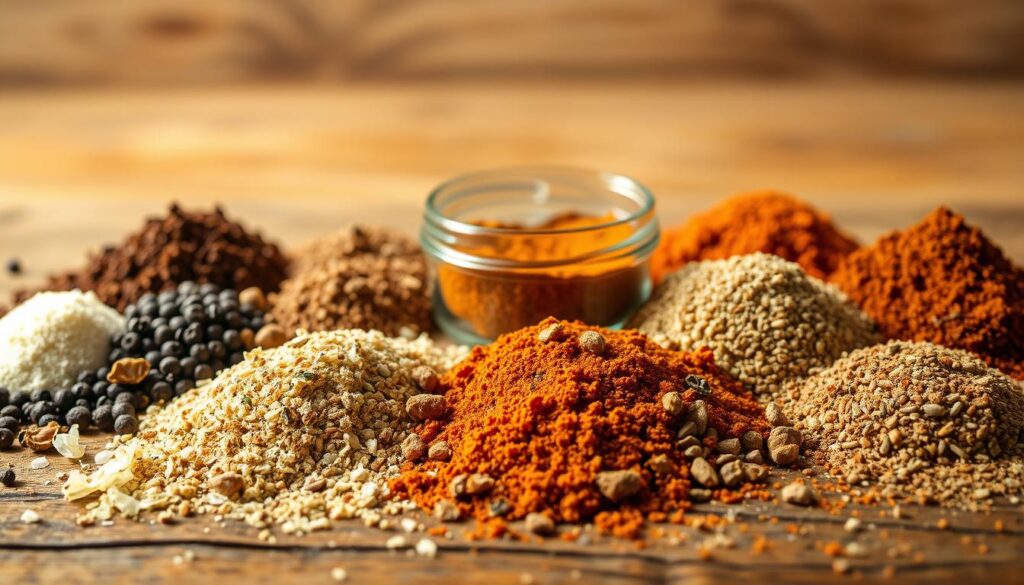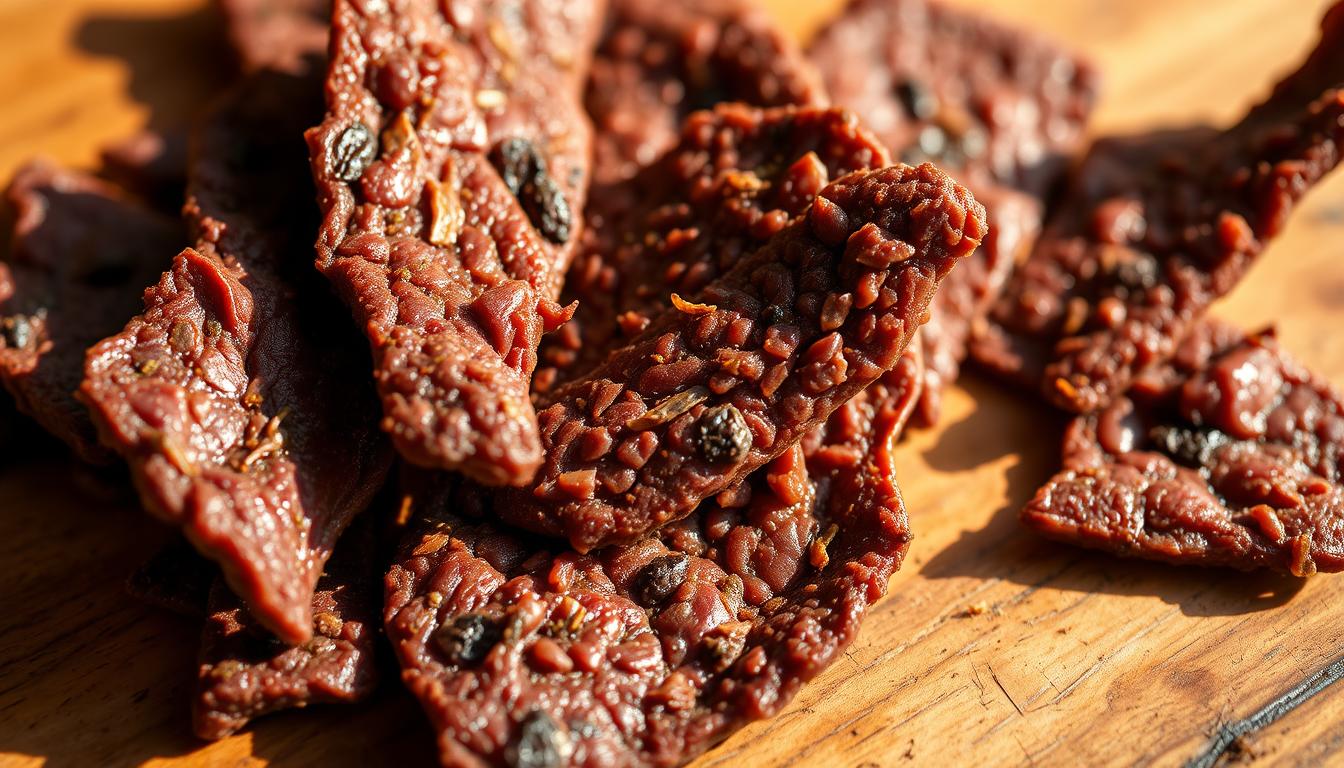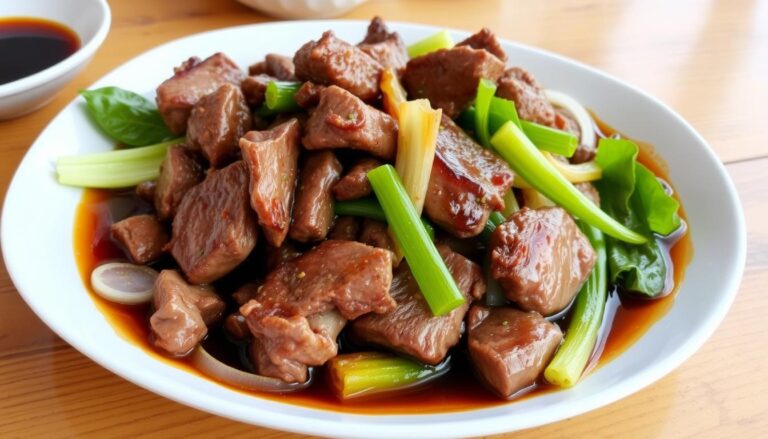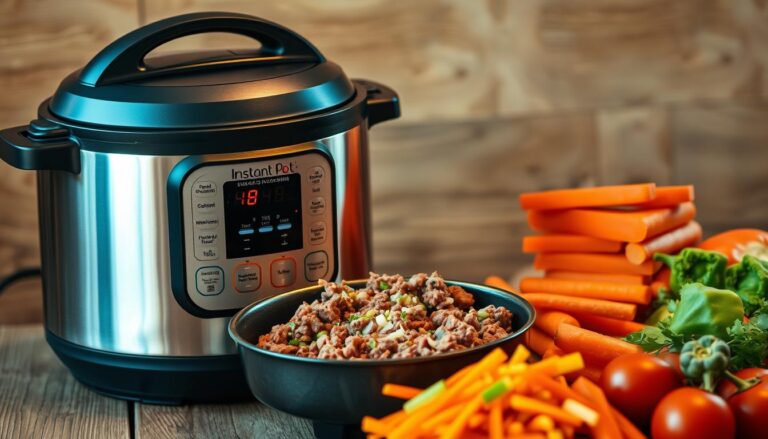Easy Ground Beef Jerky Recipe: Tender, Flavorful, and Homemade
The smell of spices and dried meat in my kitchen reminds me of my childhood. My grandfather used to make amazing ground beef jerky. It’s a snack that brings our family together through taste and tradition.
Ground beef jerky is more than a snack; it’s a fun cooking project. It doesn’t matter if you’re experienced in the kitchen or just starting out. This recipe is easy and rewarding. You’ll see how lean ground beef can become a tasty, protein-rich snack.
When you make your own ground beef jerky, you control what goes into it. Say goodbye to unknown additives and preservatives. With basic tools and quality ground beef, you can make a delicious snack for any occasion.
In this guide, we’ll cover everything you need to know about making great ground beef jerky. We’ll talk about choosing the right meat and how to dry it perfectly. Soon, you’ll be a pro at making jerky.
Table of Contents
Understanding Ground Beef Jerky Basics
Ground beef jerky is a twist on traditional jerky. It turns hamburger meat into a tasty, protein-rich snack. This version has its own special qualities that make it fun for those who love making jerky at home.
Exploring ground beef jerky recipes shows you a flexible way to make a tasty dried meat snack. It’s different from traditional jerky, offering more ways to prepare and flavor it.
What Makes Ground Beef Jerky Different
Ground beef jerky has some key differences:
- It has a smoother, more even texture than whole muscle jerky.
- It can soak up marinades and seasonings better.
- The meat is more evenly distributed.
- It’s easier to shape into strips.
Benefits of Making Jerky from Ground Beef
Using hamburger to make jerky has many benefits:
- It’s a cost-effective option compared to whole muscle cuts.
- It takes less time to prepare.
- You can customize flavors more easily.
- It’s more affordable for making large batches.
Best Types of Ground Beef to Use
For the best ground jerky, choose lean ground beef with 10% fat or less. Leaner meat helps preserve it better and keeps it fresh longer. Opt for ground beef with little fat marbling for the right texture and to avoid spoilage.
Pro tip: Choose grass-fed beef for enhanced flavor and nutritional value!
Essential Equipment and Tools for Making Jerky
Making tasty ground beef jerky needs the right tools for safety and great taste. Start by picking the best tools for making homemade snacks.
A top-notch ground beef jerky dehydrator is key. It should have precise temperature control for safe drying. Choose a digital model with adjustable settings for consistent drying at 145-165°F.
- Food dehydrator with temperature control
- Jerky gun for uniform meat strips
- Mixing bowls
- Parchment paper
- Meat thermometer
- Storage containers
The jerky gun is crucial for making even strips from ground beef. It helps your meat dry evenly in the dehydrator. Stainless steel guns are durable and simple to clean.
Pro tip: Invest in a reliable meat thermometer to ensure your jerky reaches safe internal temperatures during the curing process.
When picking a dehydrator, think about its size, how easy it is to clean, and extra features. Some models have multiple trays for bigger batches of your favorite snack.
Ground Beef Jerky Recipe Ingredients
Making tasty homemade jerky begins with picking the right stuff. Your beef jerky marinade and seasoning can turn regular ground beef into a tasty snack. It’s full of flavor and protein.
Knowing what makes good jerky is key for the perfect taste and texture. Let’s look at the main ingredients you need to make your own tasty jerky.
Main Ingredients
The base of any great jerky is top-notch ground beef. Choose lean meat with little fat to keep your jerky tasty and fresh.
- Lean ground beef (90% lean or higher)
- Cold water
- Breadcrumbs (optional, for binding)
Seasonings and Spices
Your homemade seasoning is where the magic is. A great beef jerky marinade can make your jerky go from good to amazing.
- Kosher salt
- Black pepper
- Garlic powder
- Onion powder
- Optional flavor enhancers:
- Smoked paprika
- Chili powder
- Brown sugar
Curing Agents and Preservatives
To keep your jerky safe and fresh, use curing agents. Prague Powder #1 (sodium nitrite) is a common choice. It stops bacteria and keeps the jerky’s color.
Pro tip: Always follow recommended curing agent measurements to guarantee safe consumption.
With these ingredients, you’re set to make a beef jerky marinade that will wow your taste buds and keep your snack game strong.
Preparing Your Ground Beef for Jerky Making
Making tasty ground beef jerky starts with good meat prep. Success comes from mixing and seasoning the beef right before drying. You want even flavor and the right texture.
Start with lean ground beef, low in fat. Fat can spoil the jerky and shorten its life. Look for beef that’s about 90% lean for the best taste.
- Choose fresh, high-quality ground beef
- Keep meat cold during preparation
- Mix seasonings thoroughly
- Avoid overworking the meat mixture
Temperature is key when preparing your jerky. Chill the meat mix in the fridge for 30-45 minutes before shaping. This helps the seasonings stick and makes the meat easier to shape.
“The secret to great jerky is in the preparation” – Jerky Making Experts
Seasoning is crucial for your jerky. Mix spices lightly to avoid a wet mix. Gently knead the seasonings to prevent tough jerky.
For the best drying results, use clean hands or gloves. This keeps the jerky safe and tasty.
Step-by-Step Ground Beef Jerky Recipe
Making your own ground beef jerky is a fun cooking journey. It lets you create a tasty, protein-rich snack at home. The steps might seem hard, but with practice, you’ll get the hang of it.
To make ground beef jerky, you need to pay close attention. Each step is important for safety and flavor. We’ll guide you through each stage to help you make perfect jerky every time.
Mixing the Meat and Seasonings
First, pick lean ground beef with little fat. Fat can make the jerky spoil fast. In a big bowl, mix the ground beef with your chosen seasonings:
- Salt for preservation
- Black pepper for heat
- Garlic powder for depth
- Paprika for color
Forming the Jerky Strips
A jerky gun is key for making even strips. Press the seasoned meat through the gun onto dehydrator trays. Make sure the strips are about 1/4 inch thick for even drying.
Dehydration Process
Dehydrate the jerky at a steady 165°F. This temperature kills off bacteria. It usually takes 4-5 hours, depending on your dehydrator. Flip the strips halfway to dry evenly.
Pro tip: Your jerky is done when it bends without breaking and feels dry. Keep it in an airtight container to stay fresh.
Drying Times and Temperature Guidelines

Getting the jerky right means controlling temperature and time well. Your ground beef jerky dehydrator is key to making safe and tasty snacks. The best drying temperature for ground beef jerky is 165°F. This ensures it’s safe to eat and has the right texture.
Drying times depend on a few things:
- Meat thickness
- Desired texture
- Moisture content
- Dehydrator model
Ground beef jerky usually takes 4-6 hours to dry. Thinner strips dry quicker, while thicker ones take longer. To check if it’s done, see if it bends without breaking. Properly dried jerky should bend without breaking.
Pro tip: Always use a meat thermometer to verify the internal temperature reaches 165°F for food safety.
Look out for these signs during drying:
- Meat turns dark and leathery
- No visible moisture when pressed
- Strips crack slightly when bent
Be careful with your dehydrator settings. Too high and the jerky gets tough. Too low and it might not be safe. Making perfect homemade jerky takes patience and careful attention.
Storage and Preservation Methods
Keeping your homemade ground beef jerky fresh and safe is key. The right storage methods can make your healthy snacks last for months.
Handling your jerky with care is important. The right storage can make your tasty snack last longer.
Proper Packaging Techniques
Good packaging is the first step in keeping your jerky fresh. Here are some tips:
- Use airtight containers with tight-sealing lids
- Opt for vacuum-sealed bags for extended storage
- Separate jerky pieces with parchment paper to prevent sticking
- Choose containers that block light and moisture
Shelf Life Guidelines
The length of time your snacks last depends on a few things:
- Room temperature storage: 1-2 months
- Refrigerated storage: Up to 3 months
- Frozen storage: Up to 6 months
Storage Conditions
For the best preservation, store your jerky in:
- Cool, dark places
- Low humidity environments
- Sealed containers away from direct sunlight
Pro tip: Always check for signs of spoilage like unusual odors, mold, or changes in texture before consuming stored jerky.
By following these tips, your homemade jerky will stay fresh and healthy for a long time.
Flavor Variations and Seasoning Options

Creating unique homemade jerky seasoning can make your ground meat jerky stand out. By trying different flavors, you can make jerky that excites your taste buds. It also shows off your cooking skills.
Start your jerky flavor adventure with these exciting seasoning combinations:
- Classic Spicy Blend: Combine cayenne pepper, black pepper, and red pepper flakes for a heat-packed jerky experience
- Sweet and Smoky: Mix brown sugar, smoked paprika, and chipotle powder for a rich, complex flavor
- Asian-Inspired: Blend soy sauce, ginger, garlic powder, and a touch of sesame oil for an umami-rich profile
When trying out homemade jerky seasoning, think about how spices change the texture. Dry spices make the jerky firmer. Liquid marinades can make it softer.
“The secret to great jerky is balancing flavors and understanding how each ingredient interacts with the meat.” – Professional Jerky Maker
Pro tips for perfecting your jerky seasoning:
- Start with small batches to test flavor combinations
- Use fresh, high-quality spices for maximum flavor impact
- Let seasoned meat rest before dehydrating to enhance flavor absorption
Remember, making perfect jerky is an art. Don’t be afraid to try new things and create your own special seasoning blend!
Conclusion
Making protein-rich jerky treats at home is more than a cooking project. It’s a journey into creating delicious, nutritious snacks that you love. By mastering the art of ground beef jerky, you’ve opened a world of culinary creativity.
You can control ingredients, flavors, and quality with every batch. This lets you make snacks that are just right for you.
Your skills in making healthy jerky snacks save money and offer a protein-packed alternative. You can turn ordinary ground beef into tasty, portable treats. These are great for hiking, road trips, or quick energy boosts during busy days.
Remember, jerky making is a skill that grows with each batch. You’ll learn more about seasoning, drying techniques, and what you like. Don’t be afraid to try new spice blends, meats, and drying methods to find your unique jerky style.
With practice, you’ll become a home jerky expert. You’ll impress friends and family with your homemade protein-rich jerky treats. Your kitchen will become a place where you create nutritious, flavorful snacks that are better than any commercial product.




